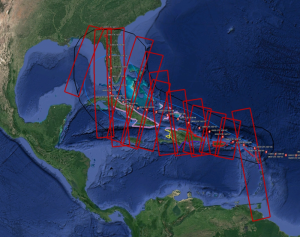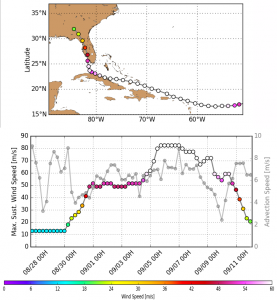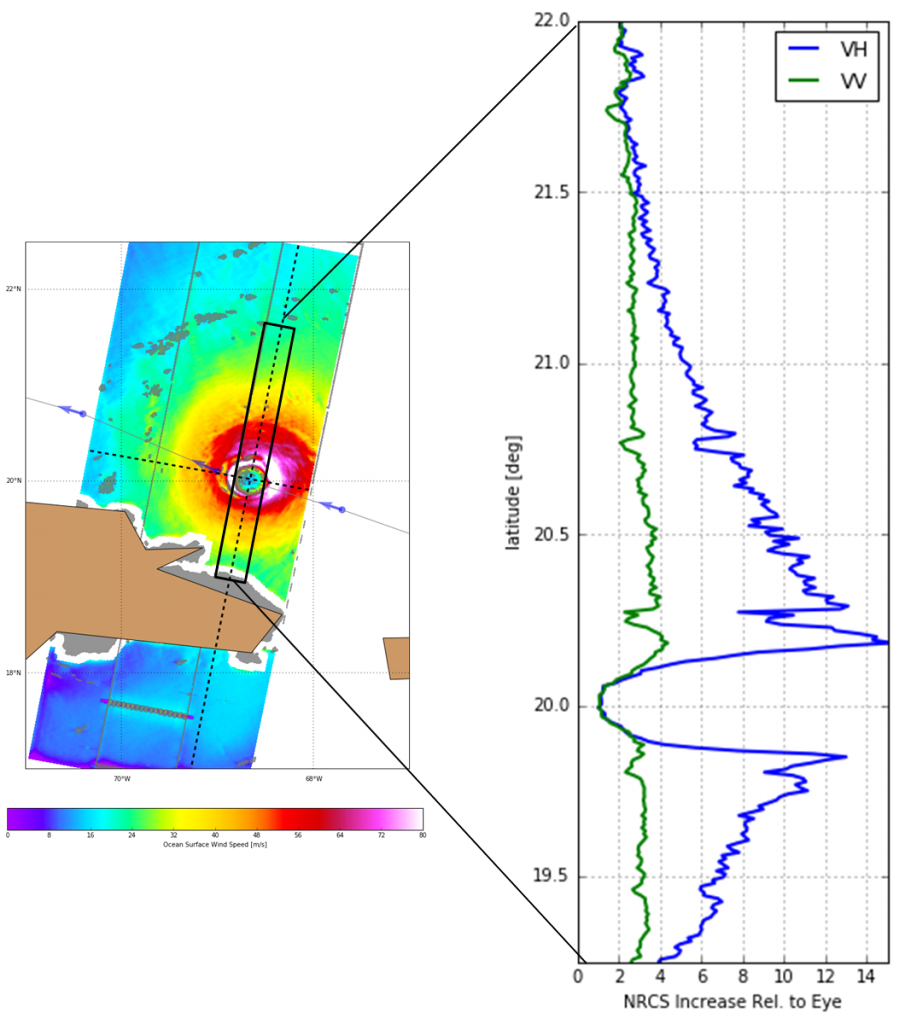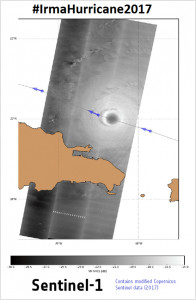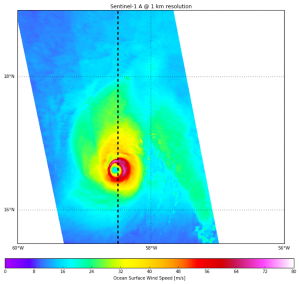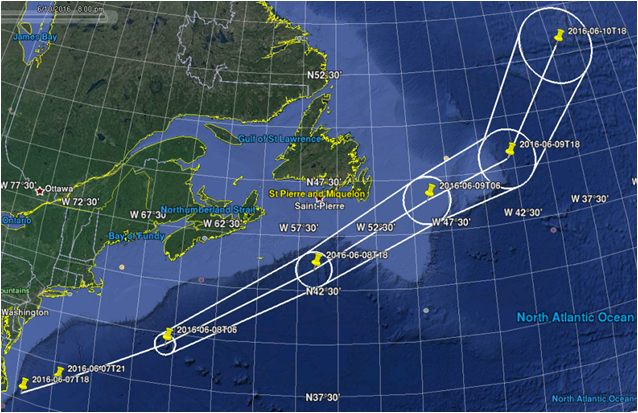ESA launched the SHOC campaign during the peak of the 2016 cyclonic season to try and test a rapid-response programming of the Sentinel-1 missions, compared with other measurements. The new capabilities of the onboard SAR sensors will enable to improve storm knowledge and forecast.
Hurricanes are one of the most devastating natural phenomena. If storm tracks quality has significantly improved recently, this is not the case for storm intensity – especially at high resolution. To date, Synthetic Aperture Radar (SAR) is certainly the only sensor able to provide a hundreds of kilometer-wide description of a hurricane with the highest resolution to measure these parameters when the storm is very severe with extreme winds and very small radius of maximum wind speed.
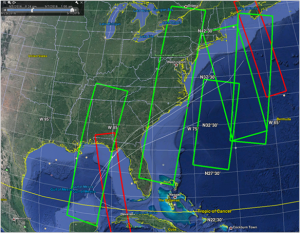
All S1 acquired acquisitions over Hurricane Hermine (green for Extended Wide mode, red for Interferometric Wide mode) with successive forecast trajectories.
In that frame, the European Space Agency and the Sentinel-1 Ocean study consortium launched an observation campaign, SHOC (standing for Satellite Hurricane Observation Campaign), planned during the 2016 hurricane season. Acquisitions were performed over Northern Atlantic and Northern Pacific Basins in August and September 2016 to target both typhoons and hurricanes during the peak of the cyclonic season.
The aim is to collect satellite observations over such extreme events, co-located with other data sources, taking in particular benefit from Sentinel-1A measurements, complementing low resolution (about 40 km) radiometer winds. Observing ocean surface night and day and through clouds at high resolution (50 m) and with wide coverage (400 km swath), Sentinel-1 is expected to provide a high resolution wind speed synoptic view of hurricanes.
The main challenges for SHOC are to improve our understanding of microwave radar measurements over extreme events and provide key parameters for tropical cyclones characterization, and to do so based on Sentinel-1 late programming scenario. This campaign was organized within the framework of the SEOM ESA program as part of the Sentinel-1 Ocean study including CLS, IFREMER, NORUT and OCEANDATALAB, and supported by a worldwide user community. The SHOC consortium benefited from ESA Sentinel-1 mission planning team who made possible programming late acquisitions over hurricane tracks. These tracks were kindly provided by NOAA (National Oceanic and Atmospheric Administration) over the Atlantic, Central and Eastern Pacific Ocean while hurricane forecast tracks over the Western Pacific Ocean were obtained through the NMC (National Meteorological Center of the China Meteorological Administration).
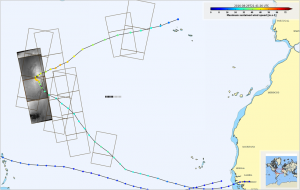
Sentinel-1A acquisition over Gaston along its path. Color-coded tracks indicate maximum sustained wind speeds measured along hurricane paths
Among the 70 Sentinel-1 passes scheduled by the mission planning team over the hurricane forecast tracks, 22 images capturing the hurricane/typhoon eye were gathered. Tropical cyclones were captured at different development stages. Some tropical cyclones like Lester and Gaston have been imaged by Sentinel-1 up to ten times each, including at very intense stages. The most intense winds expected to be measured by Sentinel-1 were captured over Typhoon Lionrock and Hurricane Lester, respectively in Category-3 and 4 on the Saffir-Simpson hurricane wind scale at acquisition time, corresponding to maximum sustained winds between 50 and 58 m/s for Lionrock, 59 and 69 m/s for Lester.
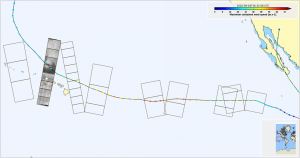
Sentinel-1A acquisition over Lester along its path. Color-coded tracks indicate maximum sustained wind speeds measured along hurricane path.
Sentinel-1 images over open ocean areas were acquired in Extended Wide TOPS mode (400 km-wide swath and 50 m resolution) and in Interferometric Wide TOPS mode over coastal areas (250 km-wide swath and 20 m resolution), all of them in dual polarizations.
The availability of the cross-polarization can greatly complement the co-polarized channel due to its higher sensitivity under extreme wind conditions, which will improve Sentinel-1 capability to describe such conditions by better resolving extreme winds for instance.
Reference data for high wind speed have been provided by other remote sensing sensors such as radiometers (SMOS, AMR2 or SMAP), analysis from best tracks and dedicated measurements from the NHC, National Hurricane Center (USA). Indeed, during the hurricane season, NHC organizes air flights with both radiometers and drop-sounders on over the Gulf of Mexico, West North Atlantic or East Pacific regions.
SHOC initiative has shown the possibility to trigger Sentinel-1 acquisitions within less than 24 hours over monitored hurricanes. The archive accumulated over summer 2016 has already given the possibility to develop first prototype dual-polarized winds showing a much better retrieval of the overall wind field and extremes. The new dual-polarization capability of Sentinel-1 should directly benefit to Copernicus end users in delivering higher quality ocean wind measurements. This demonstration sets the ground for future Copernicus services of operational extreme wind monitoring, providing a unique description of storms at high resolution before they reach populated areas. It also provides a rich dataset to better understand and forecast these phenomena.
SHOC will also help to prepare the next European Earth Observation missions since the new generation scatterometer, MetOp-SG SCA, will also perform cross-polarization observations. In this matter, the availability of a wide dataset of cross-polarized C-band measurements from Sentinel-1 constelation and derived algorithm will help prepare the exploitation of this future European satellite.
More information on the SHOC hurricane observations with Sentinel-1 will be given in the upcoming weeks.
http://eoda.cls.fr
http://ovl.oceandatalab.com/
Data Access
Sentinel-1 products acquired within SHOC initiative are accessible via the scihub (www.scihub.esa.int). Also, SHOC archive can be accessed via ftp (please email to rhusson@cls.fr).
